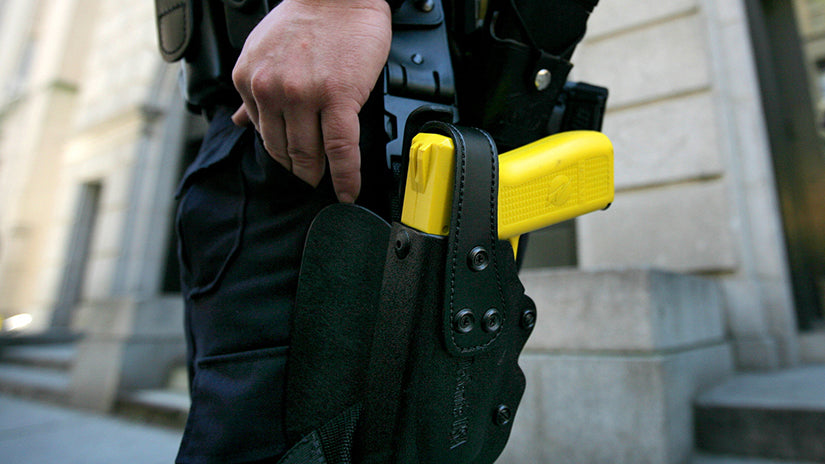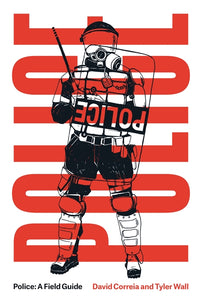The definition of Taser
A 2012 Amnesty International study found that between 2001 and 2012 more than 500 people had been killed by police in the United States and Canada after being Tasered. In nearly all cases, Tasers were used against unarmed people as a pain compliance tactic.

An excerpt from Police: A Field Guide by David Correia and Tyler Wall, a radical glossary of the vocabulary of policing that redefines the very way we understand law enforcement. Now available as a FREE ebook here.
A Taser is a handheld, battery-powered conductive energy device, or stun gun, that the police and military use as a “less-than-lethal” weapon. It delivers 50,000 volts of electrical current into a person’s body via electrically charged darts or electrodes attached to wires. Police are trained to fire the darts at a suspect in order to produce total neuromuscular incapacitation. Police departments purchase a version that comes with a “drive stun” mode that allows police to place the weapon directly on a person and drive the electrical current directly into the body. Police call this a pain compliance tactic, though a number of Department of Justice investigations of police use of Tasers describe this tactic as “street punishment.”
A common slang term for a Taser among police and its victims is “cattle prod.” The analogy is not coincidental. The first police conductive energy devices were in fact cattle prods. Police began using cattle prods in the 1940s for crowd control and as an interrogation tactic. Cattle prods were also used for crowd control in Alabama against civil rights demon- strators, and notorious Chicago police detective Jon Burge used electrical current and cattle prods in interrogation in order to torture confessions out of Black men. The “cattle prod” as police weapon evokes the image of the animal as the object of police interest. The Taser is a cattle prod with the Taser corporate logo embossed on its side.
The physicist who invented the Taser, Jack Cover, was inspired by science fiction novels and the Watts riots of 1965. He recalled that he read a newspaper article “about a man who had harmlessly gotten stuck on an electric fence for three hours . . . the current immobilized his muscles, and I thought, ‘Why not convert that into a hand item?’”
The United Nations declared Tasers a tool of torture in 2007. The American Civil Liberties Union has documented a pattern of Taser use by police against children, pregnant women, people who suffer from mental illness or are in mental health crises, and people who fail to “properly” comply while passively resisting police commands. In December of 2009 two Albuquerque, New Mexico police officers fired Tasers in drive-stun mode into the body of an unarmed man who had refused to comply with police orders and who they knew had previously poured gasoline on himself. He burst into flames. The ACLU recorded thirty-one Taser-related deaths in the United States between 2001 and 2008. In 2015 alone the Washington Post recorded forty-eight deaths associated with the police use of Tasers.
Tasers are made by Axon, formerly called Taser International, a US-based weapons manufacturer that sells electrical armaments to the military and police, including a number of versions of the Taser handheld stun gun. It claims electrical weapons are a safe, less-than-lethal option for police. The broad adoption of Tasers—more than 15,000 police and military agencies worldwide use them—suggests that police recognize force as an unresolvable political problem, to which Tasers provide a technical solution. In other words, Tasers depoliticize police violence and depict it instead as merely a problem of insufficient tools.
A 2012 Amnesty International study found that between 2001 and 2012 more than 500 people had been killed by police in the United States and Canada after being Tasered. In nearly all cases, Tasers were used against unarmed people as a pain compliance tactic. In May of 2011, Waterbury, Connecticut police officer Adrian Sanchez arrested twenty-six-year-old Marcus Brown for acting erratically and failing to comply with officer commands. He handcuffed Brown and placed him in the back of his patrol car. According to Sanchez, Brown continued to act erratically, so Sanchez opened the door of his squad car and fired his Taser into Brown’s chest. Brown died less than an hour later.
Police often claim that the deaths that follow from their use of Tasers are the result of a preexisting condition among victims called Excited Delirium Syndrome. The owners of Axon, the brothers Rick and Tom Smith, have argued that all people killed after being Tasered would have died anyway because of this condition. Police make the same argument and assert that their actions and the use of the Taser during an in-custody death is always the fault of the victim, who, because he or she died, therefore must have suffered from Excited Delirium. Neither the American Medical Association nor the American Psychiatric Association recognizes any such syndrome.
A 2009 study in the American Journal of Cardiology concluded that “Taser deployment was associated with a substantial increase in in-custody sudden deaths.” A 2011 study by the US Department of Justice concluded, however, that “there is no conclusive medical evidence within the state of current research that indicates a high risk of serious injury or death from the direct or indirect cardiovascular or metabolic effects of short-term [conducted energy device] exposure in healthy, normal, nonstressed, nonintoxicated persons.”
Note how the DOJ study defines “less-than-lethal” through a conditional claim: Taser is always less-than-lethal if used against “healthy, normal, nonstressed, nonintoxicated persons.” Since a Taser is not lethal for a “normal” or “healthy” person, a Taser cannot be the cause of death. Thus if a person dies after being Tasered by the police, it is only because that person is not “normal” or “healthy.” This kind of logic absolves Axon and police of any wrongdoing, and instead blames the victim for their own death.
What is more dangerous, a Taser in the hands of police, or the medico-legal argument about its use that absolves police of responsibility for the dead they leave? Consider again Marcus Brown, who walked into the emergency room of a Waterbury area hospital just after midnight in May 2011 seeking medical assistance. He was upset and agitated. A receptionist refused to admit him and instead called police. Officer Sanchez handcuffed Brown and placed him in the back of a patrol car. Sanchez, who in his report described Brown as agitated and upset, fired his Taser into Brown’s chest, an unarmed, restrained man who Sanchez knew to be stressed and seeking medical assistance. A subsequent Connecticut Division of Criminal Justice investigation exonerated the officer. The report reads less like an investigation of Sanchez and more like a review of Taser’s immutable safety. Since the DOJ study exonerates Axon, Connecticut exonerated Sanchez. “Officer Sanchez could not reasonably believe that his actions were likely to cause serious or lasting physical injury to Mr. Brown” and therefore “the use of [the Taser] cannot be determined to have caused Mr. Brown’s death.”

